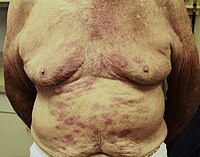
Photo from wikipedia
Leprosy due to Mycobacterium lepromatosis infection was first diagnosed in red squirrels (Sciurus vulgaris) on the Isle of Wight in 2015. Acid-fast bacilli typical of Mycobacterium species were observed histologically… Click to show full abstract
Leprosy due to Mycobacterium lepromatosis infection was first diagnosed in red squirrels (Sciurus vulgaris) on the Isle of Wight in 2015. Acid-fast bacilli typical of Mycobacterium species were observed histologically in two animals that had unusual ear and skin lesions, and pCr analysis of a range of tissues from one squirrel identified the bacilli as M lepromatosis (simpson and others 2015). In a follow-up study between 2013 and 2016 to try to determine the distribution and prevalence of leprosy on the Isle of Wight, ear pinna and skin samples were collected during routine postmortem examinations of 92 squirrels that were found dead. These animals originated from all areas of the island and deaths due to natural or unknown causes accounted for 33 per cent of cases, while 67 per cent of cases were as a direct result of human activity, in particular road traffic accidents. None of the squirrels examined exhibited the previously described signs of M lepromatosis or Mycobacterium leprae infection in red squirrels. However, it is known that M lepromatosis infection may be present in asymptomatically infected red squirrels (Avanzi and others 2016). The ear pinna and skin samples were stored at –20°C and then transferred into 70 per cent ethanol before being analysed at the Moredun research Institute. Here, they were tested by pCr for both M lepromatosis and M leprae, as previously described by Avanzi and others (2016). of the 92 samples tested, one proved positive for M lepromatosis. M leprae was not detected in any of the squirrels tested. The affected squirrel was an adult male that died in 2016. Detailed postmortem examination had not been possible as the squirrel was a casualty of a road traffic accident and was badly damaged; however, the pinnae showed no visible signs of leprosy. In the late 1980s the red squirrel population on the Isle of Wight crashed, but the cause was not investigated. since then, squirrels have returned to all parts of the island, and a study undertaken by the Wight squirrel project in the autumn of 2016 found that squirrels were present in 95 per cent of woods that are larger than one hectare. The population is relatively stable at around 2500 squirrels, and the island, which is free from grey squirrels (Sciurus carolinensis), is now one of the remaining strongholds of red squirrels in the UK. The first of the two confirmed cases of leprosy in squirrels on the Isle of Wight in 2015 had died in 2004 and the second in 2011. These cases together with the latest case show that the infection is persisting at a very low level in the population; it has almost certainly been present on the island for many years. It is rare to see a red squirrel on the Isle of Wight with pinna or skin lesions characteristic of squirrel leprosy and it is unlikely that the disease is a significant cause of mortality, especially when compared with those of anthropogenic origin (simpson and others 2013).
Journal Title: Veterinary Record
Year Published: 2017
Link to full text (if available)
Share on Social Media: Sign Up to like & get
recommendations!